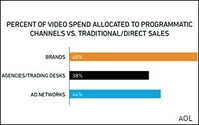Programmatic Now 60% Of Brand Video Spending, Study Finds
- by Tyler Loechner @mp_tyler, September 15, 2014
 Programmatic video has truly taken hold --
so much so that it is now the predominant way in which brands buy online video ads. According to a new report from AOL’s Adap.tv, a programmatic video ad platform, 60% of brands’ online
video ad spending is now programmatic. Agencies have also turned to ad tech, with 38% of their online video spend going through programmatic channels.
Programmatic video has truly taken hold --
so much so that it is now the predominant way in which brands buy online video ads. According to a new report from AOL’s Adap.tv, a programmatic video ad platform, 60% of brands’ online
video ad spending is now programmatic. Agencies have also turned to ad tech, with 38% of their online video spend going through programmatic channels.
The data comes from AOL Platforms’ new research report detailing the “state of the 2014 video ad industry.” AOL surveyed over 350 U.S. media and marketing professionals for the report. It was an open survey (not a survey of AOL clients) that was promoted through email marketing and social ads.
Programmatic has become the preferred method of buying video ads for brands because the quality of inventory available through programmatic channels has improved. This is evidenced through the growth of private exchanges, where publishers and brands alike are more comfortable buying high-quality inventory because there are more controls in place.
Of publishers surveyed, 32% say they are currently running a private video ad marketplace, up from 20% in 2013 -- an increase of 60%. That growth will continue in the next year: 55% of publishers said they plan to start or participate in a private exchange in the next 12 months.
AOL’s study serves to further confirm that private marketplaces are where ad traders are turning. TubeMogul recently reported that 140% more advertisers are using private video ad marketplaces compared to one quarter ago. It’s not just video advertisers that are adopting private marketplaces, either: In Europe, 27% of all ad spend went through private marketplaces in Q2 2014.
According to the AOL report, over half of publishers (51%) say they are currently making their premium video inventory available for sales via programmatic, up from 36% one year ago. Publishers said about 30% of their inventory is now sold programmatically.
“Once a method that was seen to commoditize content, programmatic has now matured past real-time bidding (RTB) and is helping publishers deliver a much more data-driven approach to selling video,” AOL writes in the report.
“Moving TV dollars online” has been the goal of the digital ad industry, and it appears ad buyers are now willing to do so. AOL asked buyer respondents -- which included ad networks, agencies and trading desks, and brands -- which channels they will be shifting budgets from to fund their increase in video ad spending in the next 12 months, and 40% said broadcast TV, while another 35% said cable TV. Almost half (47%) said they will be shifting budget from display channels to video in the next 12 months. AOL notes in the report that the number of brands willing to tap into cable budgets to fund their digital video growth has quadrupled since last year.
Speaking of TV, buyers are using data-driven/automated technologies to buy traditional TV inventory as well. Almost half (43%) of brands are currently using “programmatic” tech to buy TV inventory, with 24% of agencies/trading desks saying they are doing so. The majority of brands (60%) will soon be using programmatic to buy TV, per the report, although no sense of spend was given.
As all of the above data suggests, brands can be more aggressive than agencies with their programmatic approach, but only 13% of brands have brought programmatic video technology in-house, while 44% of agencies/trading desks have, per the report. However, AOL contends “there’s a dramatic reversal in store,” pointing out that of the 87% of brands that have not brought programmatic in-house, 88% of them plan to do so in the next 12 months.
“All the brands that [already] had brought the technology in-house said they had little choice; they did so because their agencies lacked the expertise to do their programmatic buying for them,” AOL notes in the study. This further underscores the power shift that is already taking place in the programmatic ad industry.
It’s not all sunshine and roses, however, with over half (62% and 60%, respectively) of buyers saying they are concerned about ad viewability and ad fraud. Another 40% of buyers are worried about ad verification and placement. The sell-side is worried about these issues as well, but not as much as buyers. On the viewability front, 58% of publishers say they are concerned, while 41% are concerned about ad fraud and 26% are concerned about verification and placement.
The Media Rating Council’s (MRC) video viewability standards that went into effect in late June have not made a big impact -- at least not yet. In fact, 55% of video ads were not viewable in Q2 2014, according to a recent report from video ad management platform Vindico. While buyers and sellers alike are most concerned about viewability rates, it continues to be just as large a problem as it was months ago -- if not more of a problem.
The full report from AOL can be found here.


